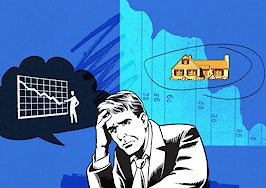 In July, Inman gazes at the glitter and glam of the luxury real estate market. Snapshots of the country’s top luxury markets, advice from leading agents, features on what affluent homeowners want now and a breakdown of the top sales of 2023 (so far) are all in the cards leading up to Inman Luxury Connect, Aug. 7-8 at the Aria in Las Vegas. Make plans to join us now.
In July, Inman gazes at the glitter and glam of the luxury real estate market. Snapshots of the country’s top luxury markets, advice from leading agents, features on what affluent homeowners want now and a breakdown of the top sales of 2023 (so far) are all in the cards leading up to Inman Luxury Connect, Aug. 7-8 at the Aria in Las Vegas. Make plans to join us now.
This is the first article in an 11-part series spotlighting housing markets in Virginia, Texas, Florida, California and New York and the U.S. market. Read the entire Summer Cooldown series here as stories are published throughout July.
April showers failed to yield May flowers in much of the country this spring, as volatile mortgage rate fluctuations continued to drive market dynamics.

Orphe Divounguy
While homebuyers were more apt to power through headwinds, would-be sellers dropped out — something that tanked new listings, sparked the resurgence of bidding wars and buoyed home price growth even as sales slowed.
“We’ve learned mortgage rates don’t just have a negative impact on buyers, right?” Zillow Senior Economist Orphe Divounguy said, adding that new listings are currently down 28 percent year over year, to about half of what was on the market prior to the pandemic. “They also have a negative impact on sellers.”
“In the spring, buyers came back, but there was an absence of sellers,” Divounguy added. “That will continue to be a challenge this summer.”
Rising mortgage rates remain the main culprit
Although the summer will be far from easy, Divounguy, Windermere Chief Economist Matthew Gardner and Redfin Chief Economist Daryl Fairweather said agents and consumers have at least one thing to celebrate — the U.S. government avoiding default. On June 2, Congress passed a bipartisan deal that enabled it to keep borrowing to pay its debts, which currently exceed $31 trillion.
The passage of the bill has drawn plenty of criticism due to more stringent Supplemental Nutrition Assistance Program work requirements, the start of student loan repayments in October and the approval of the Mountain Valley Pipeline; however, they said it saved homebuyers and homesellers from experiencing a worse-case mortgage scenario.
On the extreme end, Gardner said mortgage rates could’ve rocketed to 10 percent without the debt ceiling deal, while Fairweather and Divounguy believe rates could’ve breached the 8 percent mark — something that would’ve been enough to push the market back to fall 2022 performance levels.

Matthew Gardner
“If you think about it, for almost 98 percent of homebuyers, buying a home is the most expensive thing they will ever buy in their lives,” Gardner said. “Now, if there is uncertainty out there — regarding whether it’s the debt ceiling or we’re going to have a recession — people tend to do nothing when they’re worried.”
Since the debt ceiling deal, 30-year conventional mortgage rates have eased from a 2023 high of 6.85 percent in May to 6.67 percent during the last week of June. The drop has resulted in three consecutive weeks of week-over-week increases for purchase mortgage applications, as buyers turn their sights toward the new-home market.
“New home sales have been driving purchase activity in recent months as buyers look for options beyond the existing-home market,” MBA Deputy Chief Economist Joel Kan said in a statement on June 28. “Existing-home sales continued to be held back by a lack of for-sale inventory as many potential sellers are holding on to their lower-rate mortgages.”
Divounguy expects mortgage rates to volley between 6 and 7 percent throughout the summer. However, he said there’s a chance rates could breach the 8 percent mark depending on whether the Federal Reserve decides to increase rates (they declined to increase rates in June). If the Fed raises rates during the summer, that could result in a five to 10 percent decline in sales.
“I think it’s important for people to know the price of a home is not the cost of living in that home,” he said of the impact of rising rates. “The cost is mostly driven by the mortgage rate. We know from existing academic literature, that a one percentage point increase in mortgage rates causes housing sales to decline by five to 10 percent.”
“A year ago, mortgage rates were roughly five and a quarter percent. Today, they’re [more than 6.5 percent],” he added. “That’s a huge increase in mortgage rates and the mortgage payment for new homebuyers.”

Daryl Fairweather
As rising rates place first-time buyers in a bind, Fairweather said repeat buyers with equity or first-time buyers with greater financial means will continue to drive sales. Although multiple-offer situations will surge this summer due to low inventory, Fairweather said homesellers shouldn’t expect to see early-pandemic profits.
“The buyers who are left behind have deeper pockets and are able to take on those higher mortgage rates,” she said. “There are so few listings that the number of buyers who are willing to pay these high mortgage rates is matching the number of sellers that are out there.”
“Sellers are also discouraged from selling because of high market rates. That is probably like if mortgage rates stay above 7 percent and stay there,” she added. “I think prices will come down to reflect that because buyers aren’t willing to pay whatever it takes. Every time mortgage rates go up, some buyers block off a dramatic number.”
June will be the ‘worst month’
In addition to climbing mortgage rates, inflation will continue to influence the market as the Fed works to avoid a recession. Annual growth for the consumer price index (CPI) reached a two-year low of 4.0 percent in May; however, Gardner said food and gas prices will remain sticky throughout the summer.
“I’m happy to say that the price of eggs has now started to come down, but it’s still expensive,” he said. “Inflation has been coming down. However, prices of goods you’re buying in the stores, they’re called sticky on the downside, which means they tend to come down very slowly.”
“You’ve got these companies that make these food products or whatever that may be, they’re not going to start reducing the price of that product until demand drops enough that they have to,” he said. “Are we going to continue to buy eggs, milk, bread and gas? Yes, we are. The other categories have come down, but we don’t necessarily feel it.”
Divounguy said economists expect inflation, on the whole, to keep declining throughout 2023. However, it doesn’t solely depend on the Federal Reserve increasing rates — it also depends on controlling labor market growth.
“Cooling inflation in any slowing U.S. economy will cause yields, including mortgage rates to decline,” he said. “I look at the ISN purchasing manager index or PMI, for manufacturing and services [and] manufacturing has been contracting for months. Services, on the other hand, are still expanding, and the service industries make up a larger share of the U.S. economy.”
“Because services are still expanding, the labor demand in that sector remains very strong, and wage growth is still above a level that’s consistent with the Federal Reserve’s 2 percent inflation target,” he added. “We want the U.S. economy to cool somewhat so mortgage rates come down, but we don’t want a recession or crash. because a crash would mean an income shock and higher unemployment. And people who don’t have jobs, don’t go in and go out and buy housing.”
“What we want is a decline in inflation without an uptick in unemployment so we can see the housing market recover from that slump that it was in 2022.”
Worried about a recession? Don’t.
A recent uptick in yields for 10-year Treasury notes shows Divounguy’s ideal situation is unlikely to unfold over the next three months.
Yields on Thursday rebounded to 3.87 percent as investors become more bullish about the economy due to declining jobless claims, second-quarter gross domestic product (GDP) reaching 2 percent and the Federal Reserve issuing passing grades on bank stress tests. These four factors will likely lead to another rate hike in July, a previous Inman article explains.
“The CME FedWatch Tool, which monitors futures markets to measure investor expectations about the Fed’s next moves, puts the odds of another 25-basis point Fed rate hike in July at 87 percent,” the article reads. “But futures markets predict only a 24 percent chance of another rate hike in September.”
With this in mind, Gardner and Fairweather said the occurrence of mild recession is still a real possibility.
“A recession is definitely still in play. I hope that it doesn’t come to that, but it could,” Fairweather said.
Even if a recession does come knocking this year, Gardner said it doesn’t mean the housing market is immediately doomed.
“Yes, home prices are down right now, and we’ll see that number get worse over the next couple of months. The worst month is going to be in June. Why? Well, we saw a peak sale price in June of 2022 $413,800. So yes, it’s going to be down [compared to last year],” he said. “But then after that, because we started seeing prices pull back and balance well into January of this year, I do expect that we’ll see year-over-year price start getting better, even if a recession comes.”
“I’m putting the likelihood about 50/50 that we’ll have a recession this year,” he added. “It will not be like 2007.”
Gardner said history is on the housing market’s side, as prices usually continue to climb — albeit slower — throughout recessions.
“Historically speaking, believe it or not, other than the Great Recession, house prices go up through recessions,” he said. “In the 1980 recession, home prices went up by over 6 percent. In 1981, [they went up] three-and-a-half percent. They did drop marginally in 1991, down to a bit shy of 2 percent. In 2001, home prices went up by 6.6. Obviously, it was very different in 2008 because housing caused it.”
“We could skirt around [a recession] possibly,” he added. “But even if we don’t, it’ll be a mild one, and I certainly do not expect it to be a significant impediment to home prices.”
The bright side: New-residential sales
Divounguy, Fairweather and Gardner said the summer will, for the most part, be a continuation of spring trends with existing and pending home sales struggling to maintain traction amid double-digit drops in new listings and inventory. However, all three economists are trusting in the resilience of buyers and major life events to keep the housing market afloat over the coming months.
“We won’t see that churn (e.g. the turnover of existing housing) for the reasons we’ve already talked about,” Gardner said. “But transactions will still happen and most of them are for the classic reasons: Job change, marriage, death and divorce. That is what always happens.”

Thomas Gamble
TKI Analytics CEO and co-founder Tom Gamble said baby boomers will likely stay on the sidelines this summer, as they’re hesitant to let go of the equity they’ve built in their homes. “The fact they have an enormous amount of equity coupled with the fact that they’re in their eldering years — not old, but eldering — doesn’t make getting into the market an attractive choice right now,” he said. “And with rising interest rates, borrowing money is very, very expensive right now.”
As baby boomers take a back seat, Gamble said he’s expecting families and singles to weather market conditions this summer and seize opportunities to either purchase their first home or get out of regret purchases they made a few years ago.
“We’re starting to see regret buyers where they really did like that city life, so they’re saying, ‘Hey, wait a minute, I don’t like this as much, being out in the ‘burbs,'” he said. “So we’re seeing that reverse in trend.”
While existing-home inventory remains tight, homebuyers are turning their attention to the new-home market. As a result, new residential sales logged a 20 percent annual increase in May and continued a six-month streak of month-over-month sale increases. New home inventory was 31 percent of the total inventory in May — a 100- to 200 percent increase from the historic trends of 10 to 15 percent.
“The lack of resale homes available for sale, at just a three months’ supply, is supporting demand for newly built homes,” National Association of Home Builders Chief Economist Robert Dietz said of the new-home market’s resurgence.
The uptick in new-home sales led to the first positive homebuilder sentiment score since April 2022 and an 18.5 percent month-over-month increase in housing starts from April (841,000) to May (997,000).
“Considering how high interest rates are and the lack of inventory, buyers who are gung ho about buying may have to build it themselves,” Fairweather said. “That’s been helping the building industry, and the supply chain issues that were holding them back during the pandemic have been resolved by now. So the building industry is looking in pretty good shape, considering the economic conditions.”
The decline in material-cost growth has enabled homebuilders to offer homebuyers better deals, as evidenced by the new-home median sale prices dropping 7.2 percent year over year to $416,000. Average sale prices also declined on an annual basis; sliding from $511,400 in May 2022 to $487,300 in May 2023.
“The surge in completed homes means builders are pricing them to sell: In May, 48 percent of new homes sold for less than $400,000; a year earlier, it was 39 percent,” NerdWallet home and mortgage expert Holden Lewis told Inman last week.
Act with the future in mind
All three economists said although new-residential sales will offer a needed lifeline to the market this summer, it’s still not a panacea for homebuyers’ woes. To keep transactions on the right track, Gardner said agents will need to help homesellers and homebuyers contextualize current economic trends.
“You marry the house, but you hold hands with the mortgage rate,” he said. “If your buyer finds a home that is absolutely the one they want to live in for a long time and they can afford right now where rates are today, you can always refinance that home when rates get better.”
Divounguy and Fairweather offered similar feedback, saying that now is the time for buyers to act — especially if they’re ready to settle down and find homes they’ll live in for at least the next 5 to 7 years.
“If you love a house, you can afford it and you plan on living in that house for a while, that’s the only reason you should really be in the market today,” Divounguy said. “Mortgage rates are impossible to predict, so don’t try to make that decision simply based on whatever the mortgage rate is because ultimately you can always refinance later.”
“Barring any kind of new macroeconomic shocks, inflation is expected to cool going forward and so that ought to bring mortgage rates down,” he said while noting rates are expected to fall back into the five-percent range in 2024. “So getting in the market now simply means, ‘Hey, you know, in the near future as mortgage rates fall, I can always refinance later.”
Meanwhile, Gamble, who helps agents create business plans based on predictive analytics, said his best advice for agents this summer is to focus on referrals; build relationships with fellow agents, local business owners and vendors; find creative ways to serve clients in your database outside of sales; and stay on top of prospecting so as the market opens up in 2024, you’re already ahead of the game.
“I’m a sales guy at heart,” he said. “Now’s the time to do the work. Yeah, the market slows down in summer, but I would not treat this like any other summer. Now’s the time to work harder.”
“If you really think about where we are right now, yes we’re a little behind, ” he added. “But if you’re prospecting like heck now, your fall market should do well and be poised for success when people start to feel comfortable again coming into the market.”













